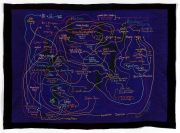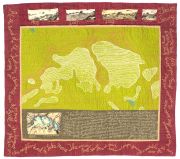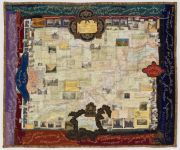Bonnie Peterson
Artist Statement / Bio
Artist Statement
The urgency of climate change motivates my artwork. I use embroidery to examine geophysical climate issues with the goal of promoting a fresh opportunity to consider climate and ethical questions. I stitch numerical graphs and text on silk and velvet fabrics. I annotate topographic maps with a labyrinth of climate variables at various future temperature and emission scenarios.
I design simple explanations for the important principles and difficult modeling scenarios in environmental science, and I use these in my work. Published scientific research and data are the foundations for each artwork. I examine and translate the abstract scientific data from the World Meteorological Organization, NOAA, NASA, & the European Environment Agency, to inspire thought for the future and to challenge people with and without a scientific background to consider the math and science of climate change. I investigate data collected by earth instruments such as satellites and ocean floats, as well as modeling from climate proxy data such as ice cores. A lengthy research and development phase is the foundation for my work.
My recent environmental work was launched by artist-scientist projects. Some of the exciting projects were with the University of Wisconsin (Limnology, biology and climate change), National Science Foundation Long Term Ecological Research program (lake chemistry, invasive species, and societal practices), Yosemite National Park (glaciology), Northern Arizona University (Fire ecology at the intersection of extreme fires and societal change), University of Arizona (Dendrochronology) and the NASA GRACE satellite program (mass of the Greenland and Antarctic ice sheets).
I hope to communicate the importance of the consequences of warming and an understanding of the dynamic nature of warming.
Biography
Bonnie Peterson is a visual artist investigating environmental and social issues using embroidery and maps. Peterson’s personal and political subjects have followed the trajectory of her life experiences from family and human rights issues to outdoor adventures and environmental science. Recent collaborations with scientists on concepts in fire ecology, atmospheric science, permafrost and other geosciences motivate her work. Peterson has exhibited widely in solo and group exhibitions in the US and abroad including the Museum of American Folk Art, Museum of Design Atlanta, Fresno Art Museum, Yosemite Museum, Notebaert Museum Chicago, Ukrainian Institute of Modern Art-Chicago, Berlin Science Week, and Art/NaturSci Pavilion Venice. She is a two-time recipient of Artist Fellowships from the Illinois Arts Council & two Artist Finalist awards, a grant from the Michigan Arts & Culture Council, the Puffin Foundation Ltd, the Illinois Committee of the National Museum of Women in the Arts and other honors. Peterson had four National Park artist residencies. Her work is in public and private collections including the Museum of Art & Design NYC. She has a BS from the University of Illinois-Urbana and an MBA from DePaul University.
Artist Essentials
- Contact Artist
- Artist Website
- Phone: 6306735530
Houghton, Michigan
United States
Northern America
Artist Social
- Facebook: Bonnie Peterson
- X: writebon
- Instagram: Bonnie Peterson































